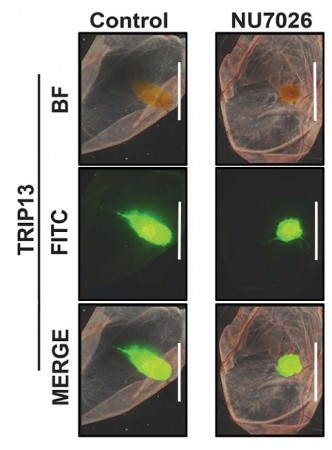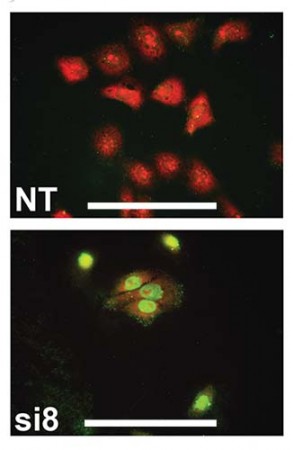Source: http://www.dentistryiq.com/
Author: DentistryIQ Editors
Imagine that you’re fighting for your life, but no matter how hard you hit, your opponent won’t go down.
The same can be said of highly treatment-resistant cancers, such as head and neck cancer. During radiation and chemotherapy, some cancer cells repair themselves to survive and thrive. Head and neck cancer is the sixth most common cancer in the world, but the late detection and treatment resistance result in a high mortality rate.
Now, University of Michigan researchers have found that a particular protein – TRIP13 – encourages those cancer cells to repair themselves, and they have identified an existing chemical that blocks this mechanism for cell repair.

Left: Untreated head and neck cancer cells are tagged fluorescent green. Right: Shows cells treated with the chemical inhibitor that blocks TRIP13, which results in a dramatically smaller tumor.
“This is a very significant advance because identifying the function of the protein that fuels the repair of cancer cells and having an existing chemical that blocks the process could speed the process of moving to clinical trials,” said principal investigator Nisha D’Silva, University of Michigan professor of dentistry and associate professor of pathology.
Typically, if scientists discover a promising drug therapy target, it takes years to develop drug compounds from scratch and move these into clinical trials.

Top: Cancer cells with TRIP13, the protein that encourages cancer cells to repair themselves. Bottom: Cancer cells in which researchers have removed or decreased TRIP13, which results in fewer cells due to cell death.
If cell DNA is damaged, and the cell cannot repair the damage, the cell dies. In head and neck cancers, D’Silva and colleagues showed how cancer cells that overexpress TRIP13 were able to repair their DNA enough to survive and continue to grow as cancer.
“Targeting this repair mechanism with specific drugs could increase effectiveness of treatment and improve survival of cancer patients,” D’Silva said. “And given the overexpression of TRIP13 in several treatment-resistant cancers, this strategy will likely be important for multiple cancers.”
Note:
Rajat Banerjee of the University of Michigan School of Dentistry is the first author of the study, “TRIP13 promotes error-prone nonhomologous end joining and induces chemoresistance in head and neck cancer,” which appeared online on July 31 in Nature Communications.

Leave A Comment
You must be logged in to post a comment.